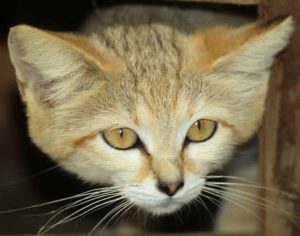It was 2 a.m. in the Moroccan Sahara, and researchers were heading back to camp after seven hours of driving through sand, dust, and prickly vegetation on their fifth and final expedition to document sand cats. Gregory Breton was chatting with their local driver, Elhaj, to keep him awake, while Alexander Sliwa spent a few more minutes squatting on the roof of the Toyota Land Cruiser shining spot lamps into the bushes.
Then, it happened. Three pairs of eyes gleamed back at Alexander through the darkness about 4 kilometers from the campsite. They belonged to young sand cats, yellowish, small wild cats with broader faces and larger ears than domestic cats.
Finding sand cats (Felis margarita) in their natural range (northern Africa, across the Middle East, and southwest and central Asia) is difficult. They barely leave any visible pugmarks, they don’t leave behind remains of their prey, and their vocalizations are quiet. They move stealthily at dusk, night, and dawn, they’re good at hiding, and their fur provides perfect camouflage when they want to vanish from observers and threats. But they don’t run away.
Finding these kittens was astonishing. The researchers spent an hour taking pictures and videos and setting up camera traps in the hopes of recording some natural behavior once they left. Based on their experience with sand cat litters in captivity, they estimated the kittens were six to eight weeks old—too small for collaring. They believe this was the first time researchers have documented wild sand cat kittens in their African range.
As they were carefully leaving the kittens, making sure they didn’t startle them, the team spotted and radio-collared an adult female that was nervously roaming around during the interaction. She could be the kittens’ mother. If they collect footage of her and follow her for a long period, they can gather data on the natural reproduction cycles and offspring dispersal of this species in the wild—all topics never before documented.
The sand cat expeditions in the Sahara started in 2013, when Alexander Sliwa—the world’s leading specialist in black-footed cats, heading a 25-year study on this species in South Africa—and Gregory Breton discovered that more sand cat sightings were being reported in Morocco. They decided to travel there and try to spot some cats.
To date, they’ve’ve spotted 29 different sand cats, radio-collared 13 of them, and collected some surprising data. For instance, sand cats are traveling more than previously thought and more than what’s been recovered for any other small cats. But they still don’t know why. Additionally, it seems this desert cat is living in select parts of the desert—and if the low density is confirmed over time, the species may not be as frequent as believed, at least in this region.
Text by Gregory Breton. For details on this project and to donate to the sand cats, see our Sand Cats of Morocco page.
 We’ve updated our Sand cat fact sheet with new information on their distribution and conservation threats.
We’ve updated our Sand cat fact sheet with new information on their distribution and conservation threats.